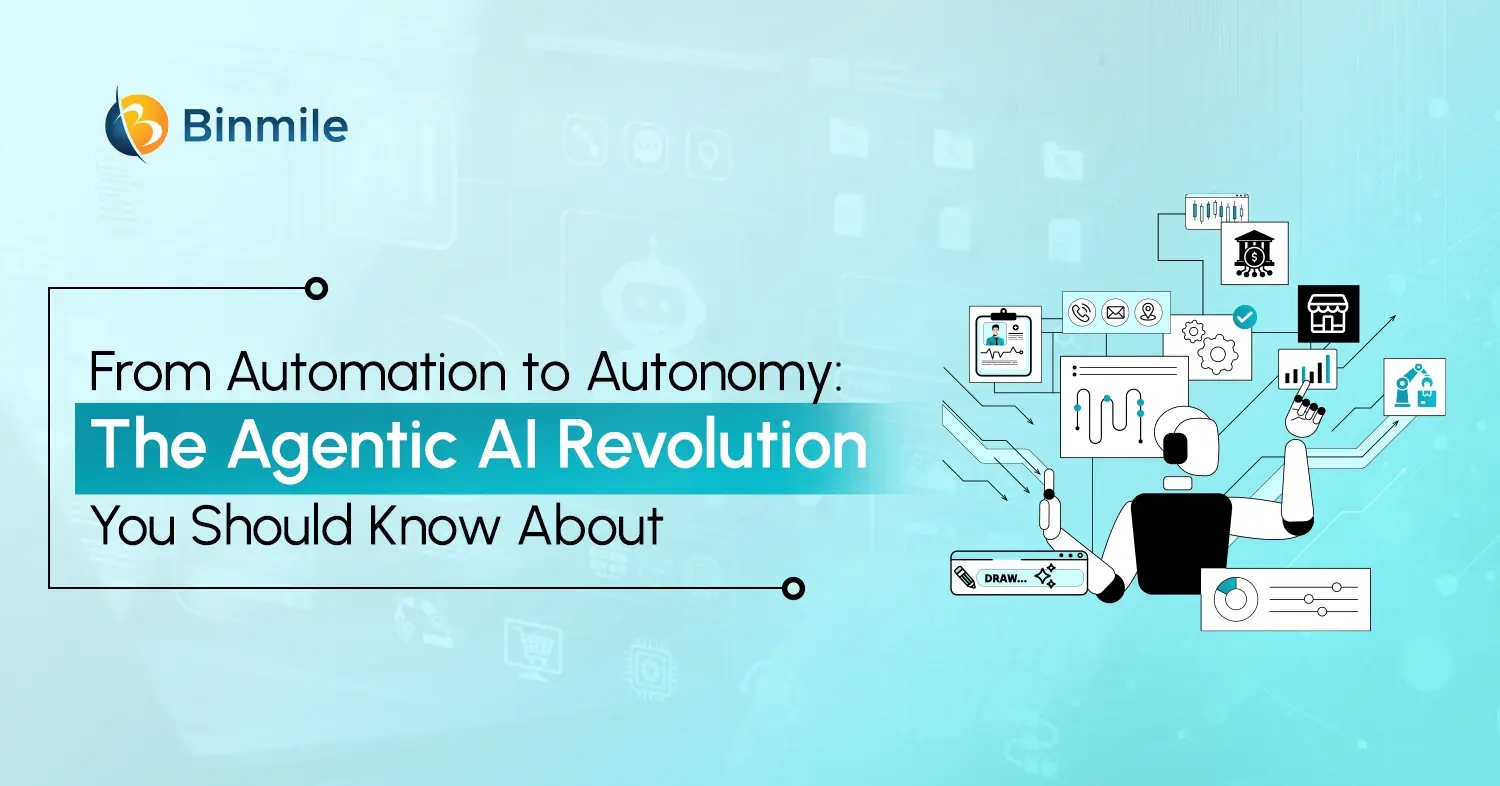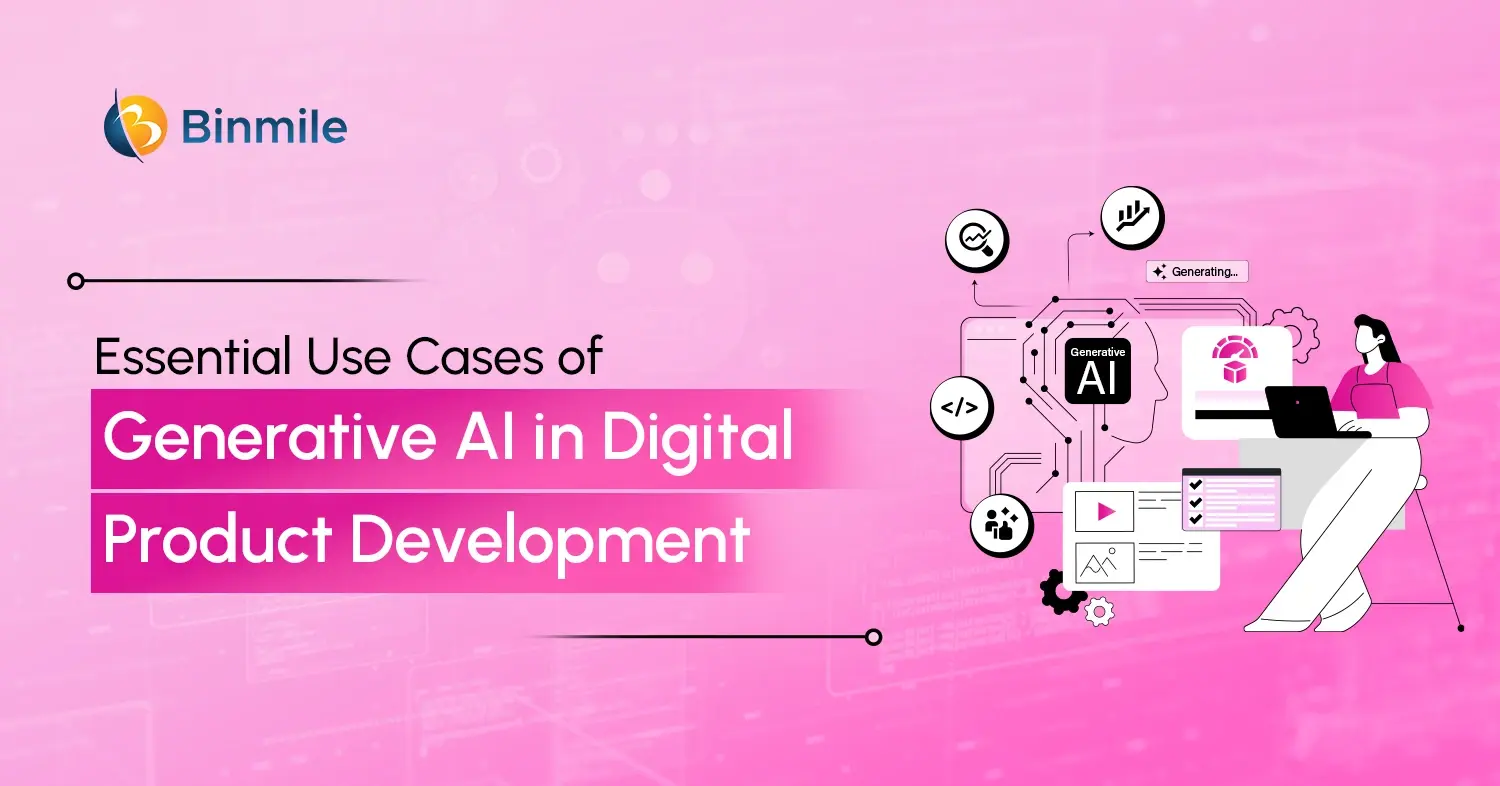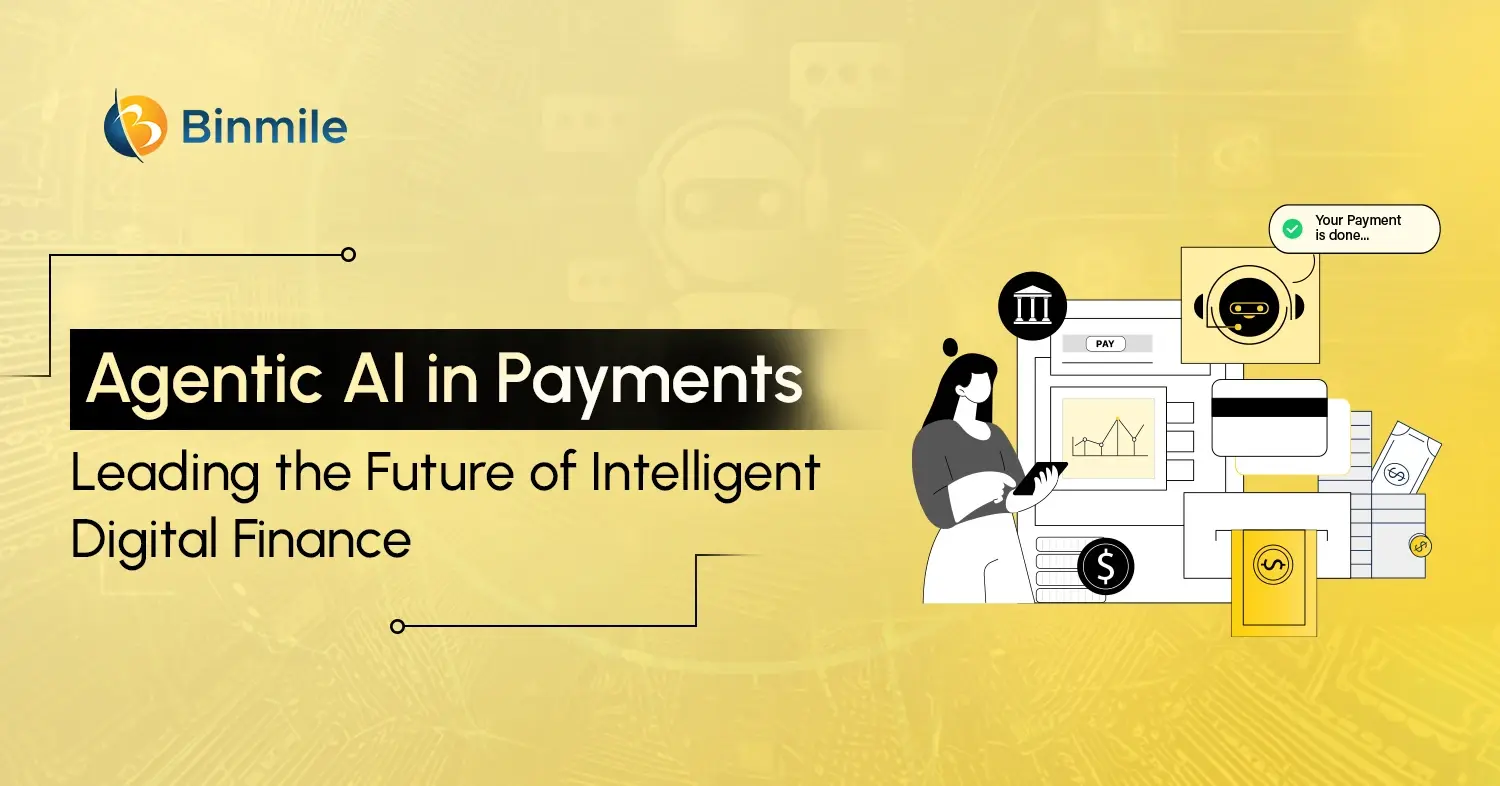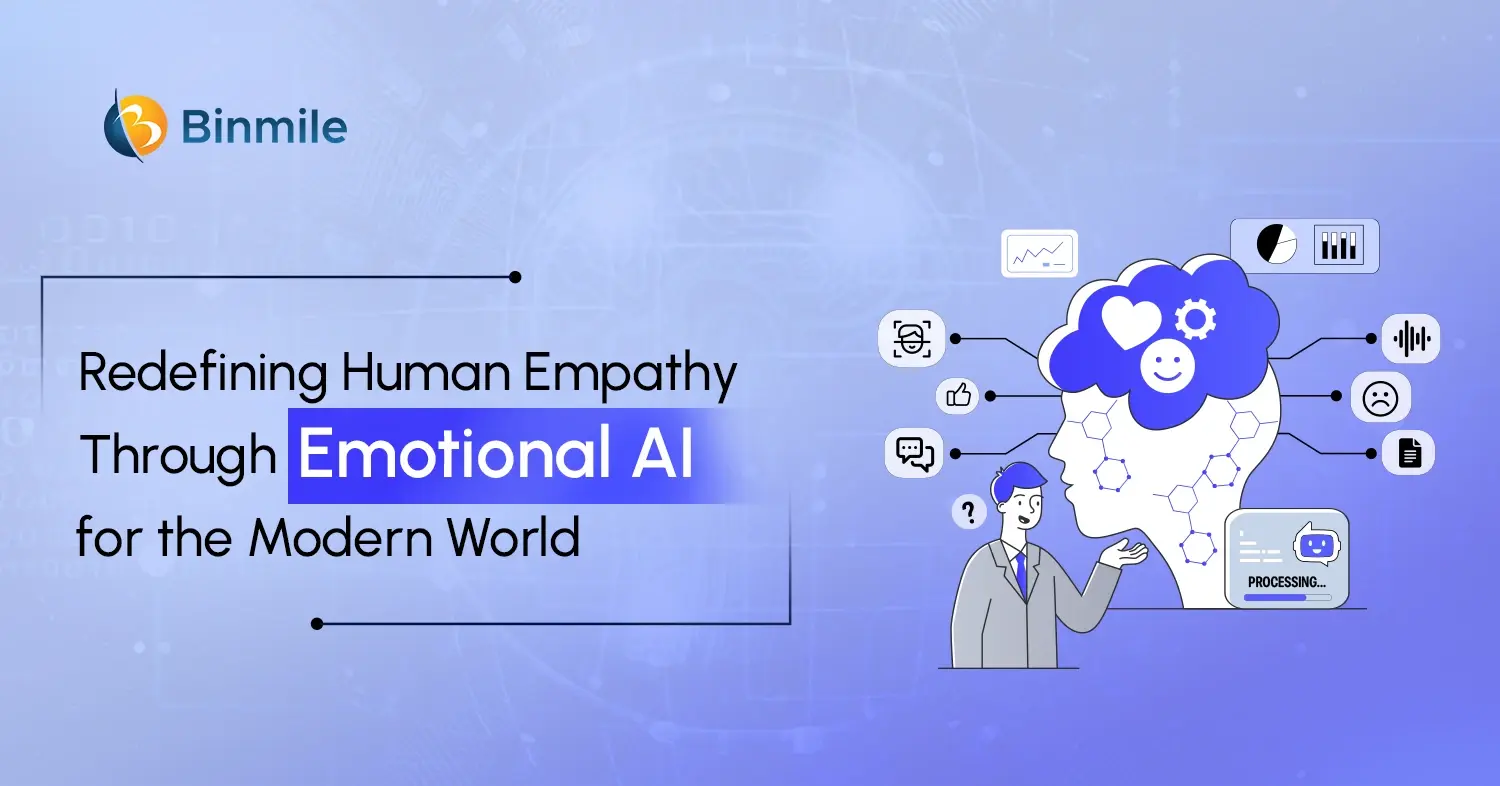To stay competitive in the evolving AI landscape, businesses are now looking ahead of systems that simply process data or generate content. With nearly 77% of business leaders worrying that they’ll miss out on the AI revolution if they don’t deploy it soon, it’s time your organization gets introduced to a new force. Agentic AI software, built to reason, adapt, and act toward specific goals, is emerging as the next step in intelligent system design. By combining contextual understanding with autonomous decision-making, it enables faster, more accurate, and more adaptable solutions. This shift is already driving advancements in innovation, automation, and operational efficiency across industries. Agentic AI tools are more than a reactive assistant; instead, they are a proactive, autonomous system that can understand, decide, and act with minimal oversight.
So, what does agentic AI vs generative AI mean? Are they the same or different? How are Agentic AI frameworks shaping the future of technology and innovation? Learning about all these will help you capitalize on these intelligent systems and enable you to be at the forefront of the future. This blog will answer these questions and give you an in-depth look at how it brings measurable gains in productivity, reduces time to market, and delivers more personalized, responsive outcomes.
What is Agentic AI?
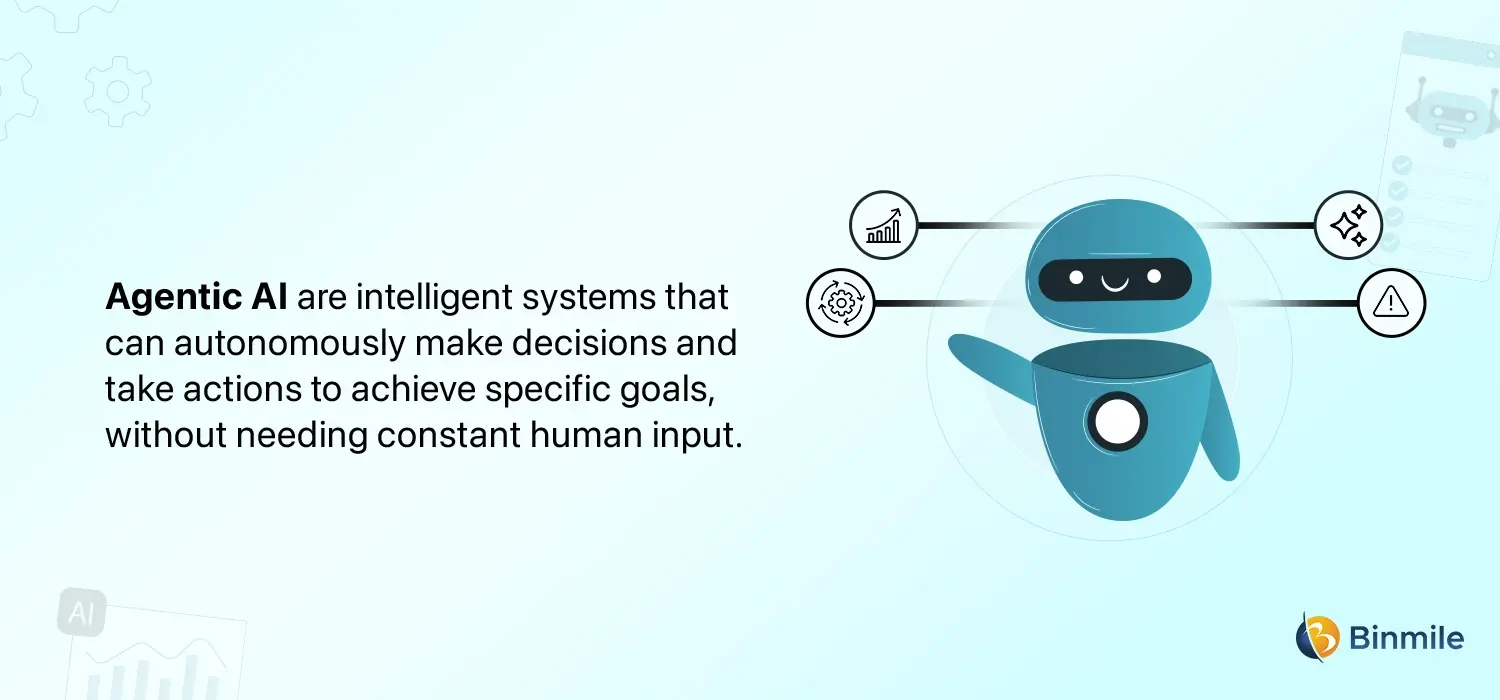
According to IBM, Agentic AI is “built on generative AI (gen AI) techniques by using large language models (LLMs) to function in dynamic environments. While generative AI models focus on creating content based on learned patterns, agentic AI tools extend this capability by applying generative outputs toward specific goals.”
So, what is agentic AI? It means Agentic AI frameworks, with their access to tools, data, and the internet, are capable of adapting to changing conditions and collaborating with other agents that can think, plan, remember, and learn from experience to get work done.
Agentic AI systems are different than traditional AI or AI agents in the sense that these two may produce text, images, or code, but the former goes beyond it. As an autonomous intelligent system, it can use that generated content to complete complex tasks autonomously by calling external tools. For instance, Agentic AI software can not only suggest when to launch, but it can also analyze audience shifts, reprioritize your campaign goals, and initiate a new strategy to maximize impact across channels.
Few agentic AI examples can be NVIDIA Agent Morpheus, Cursor AI Editor, or OpenAI Operator Agents.
Key Features of Agentic AI
- Decision-making: Agentic AI tools follow pre-defined plans and objectives and are able to assess situations and determine the next outcome with minimal human input, bridging the gap between prescriptive AI vs predictive AI by not just forecasting outcomes but acting on them.
- Problem-solving: The four steps, perceive, reason, act, and learn, allow the AI systems to collect and process data. With its capability, LLM analyzes perceived data to understand the input and integrates with external tools that are continuously improving and learning through feedback.
- Autonomy: With its unique ability to learn and operate on its own, Agentic AI software enables organizations to streamline workflows and have machines perform complex tasks with minimal human intervention.
- Interactivity: Its proactive nature allows the agentic AI systems to seamlessly interact with the outside environment and gather data to adjust in real-time and offer accurate results.
- Planning: Agentic AI software can handle complex scenarios and execute multi-step strategies to achieve specific goals.
Strategic Advantages of Agentic AI: An Overview
As AI systems, agentic AI has redefined how intelligent systems operate, bringing new capabilities across SaaS, infrastructure, and decision-support domains. Below are five foundational benefits of Agentic AI tools:
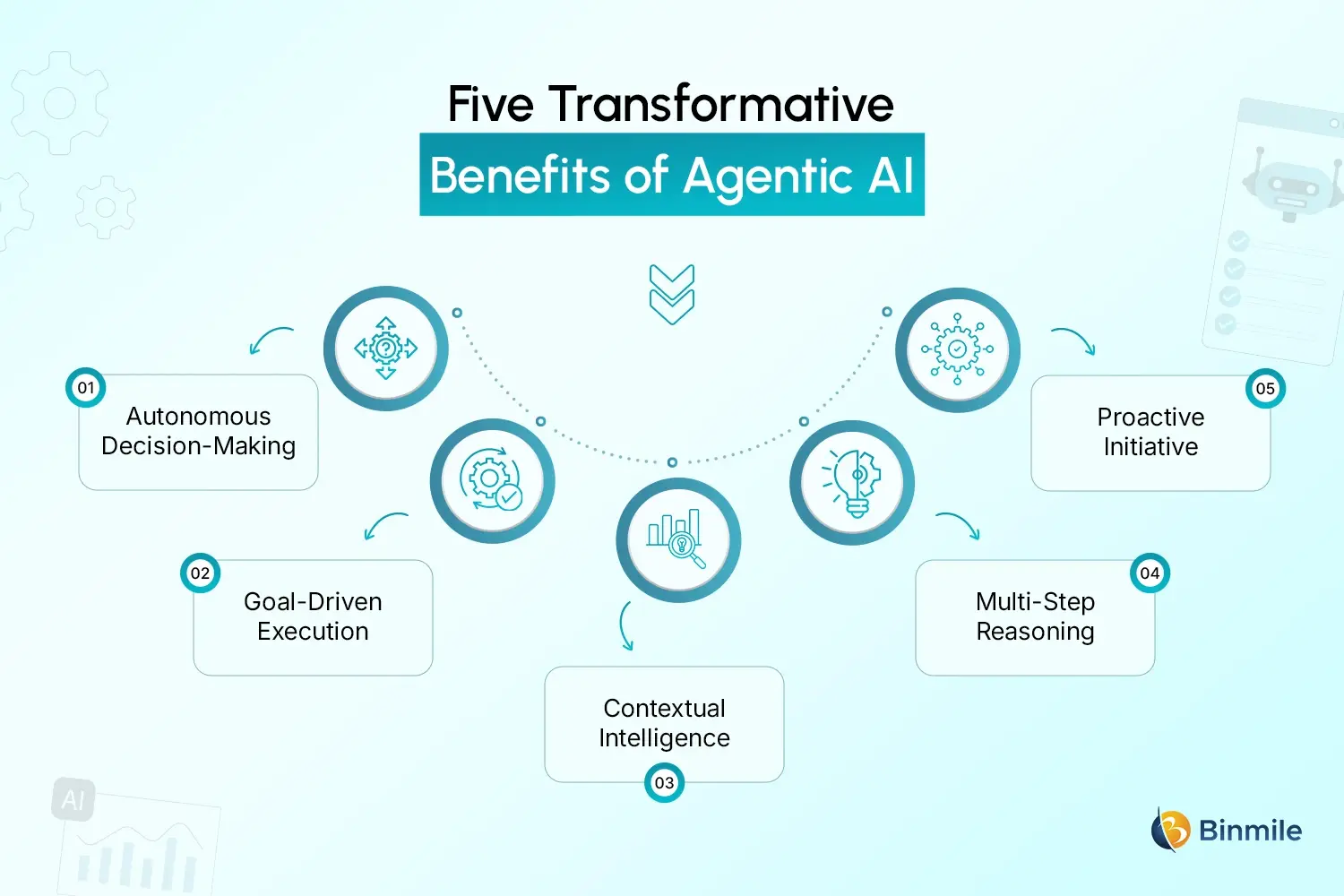
- Autonomous Decision-Making: Agentic AI systems can make independent decisions based on goals and context, reducing reliance on constant human input. This enables faster, scalable operations and frees teams to focus on higher-order strategic tasks.
- Goal-Driven Execution: Unlike reactive models, agentic AI pursues defined objectives, adjusting its actions to meet desired outcomes, ensuring agentic process automation meets business intent, improving the relevance and impact of AI-driven processes.
- Contextual Intelligence: Due to its dynamic awareness, Agentic AI tools interpret environmental signals, user behavior, and system states to adapt its responses. It enhances personalization, operational precision, and resilience in complex or evolving scenarios.
- Multi-Step Reasoning: Agentic systems can plan and execute multi-stage tasks, integrating logic, feedback, and iterative refinement. This supports sophisticated workflows, such as diagnostics, troubleshooting, or strategic decision support in SaaS environments.
- Proactive Initiative: From a passive to a proactive approach, Agentic AI tools can identify opportunities, risks, or inefficiencies and act autonomously, opening up new value in monitoring or opmization, whether AI in inventory management, infrastructure orchestration, or customer engagement..
How Does Agentic AI Work?
Agentic AI operates through a dynamic four-step loop: Perceive, Reason, Act, Learn, enabling adaptive, goal-driven systems across industries. Let’s understand them:
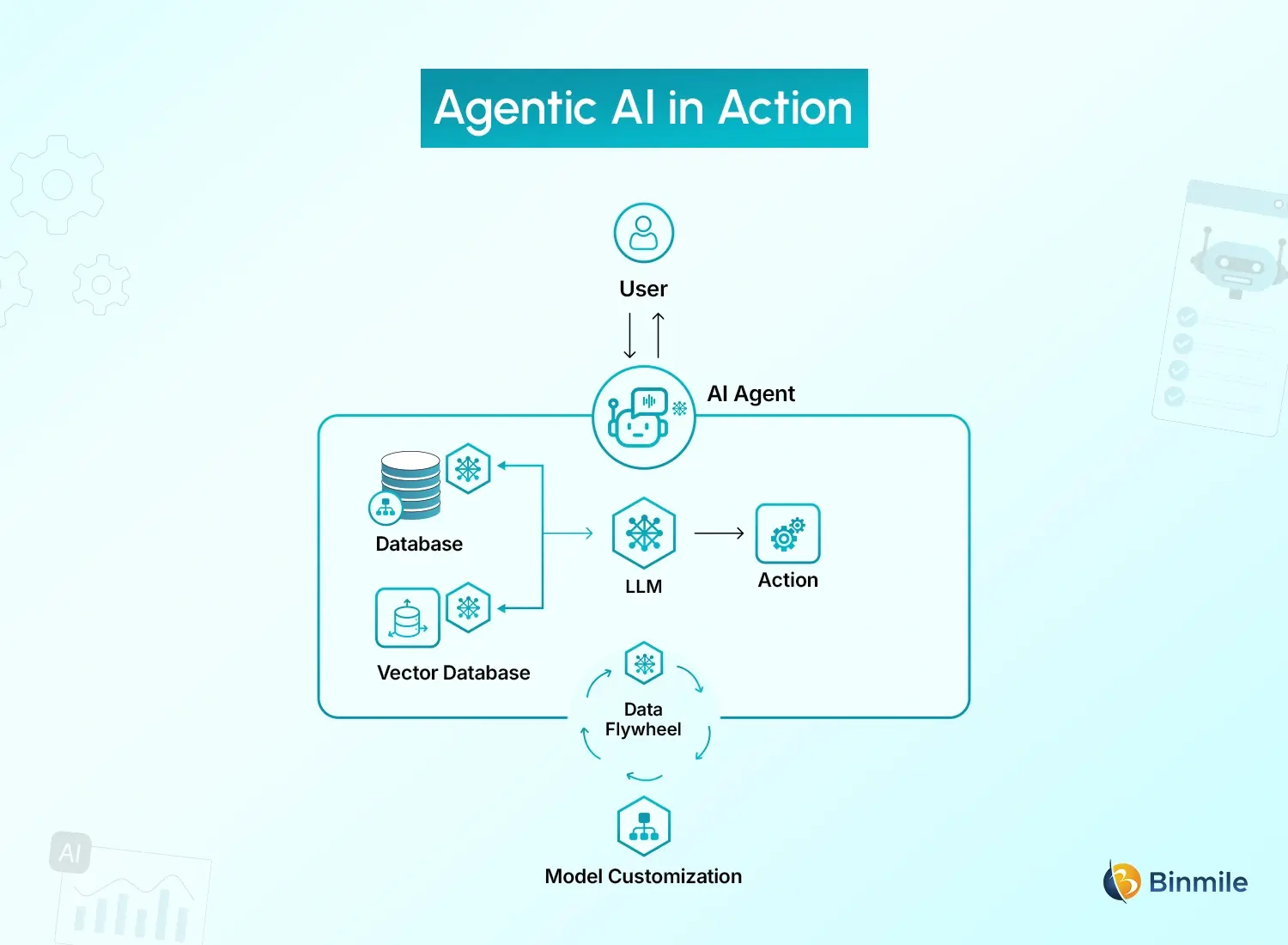
- Perceive: Agents collect and interpret data from sensors, databases, and interfaces to surface actionable signals.
- Reason: LLMs generate plans and coordinate task-specific models (e.g., for content, vision, or recommendations), often using RAG to build or upgrade GenAI strategy.
- Act: Integrated via APIs, agents execute tasks autonomously within defined guardrails, like auto-processing claims under a set threshold.
- Learn: Interaction data feeds back into the system, refining models and boosting performance through continuous adaptation.
Agentic AI vs Generative AI: What’s the Difference?
What sets apart Generative AI from Agentic AI is that GenAI models respond to prompts by producing content like text or images, while Agentic AI tools go further. These intelligent systems can autonomously make decisions and take actions to achieve complex goals with limited supervision. Below is the table to help you understand the difference between Agentic AI vs Generative AI:
| Factors | Generative AI | Agentic AI |
|---|---|---|
| Core Function | Produces content (text, images, code) based on input prompts | Takes goal-directed actions with autonomy and strategic intent |
| Initiative | Reactive; responds to user instructions. | Proactive, initiates tasks aligned with inferred or explicit goals |
| Decision-Making | Limited, it follows prompt logic without a broader context. | Context-aware, makes decisions based on evolving objectives and constraints |
| Architecture | Often model-centric (e.g., LLMs, diffusion models) | Agent-centric, integrates planning, memory, and environment interaction |
| Use Case Focus | Content creation, summarization, translation, etc. | Task orchestration, strategic execution, autonomous workflows |
What is the Difference Between Agentic AI and AI Agents?
The fundamental difference between Agentic AI and AI agents is that agentic AI is the framework, while AI agents are the building blocks that make it work. So, if Agentic AI tools understand user goals and coordinate autonomous problem-solving.
Then, AI agents are the individual components within that system, such as smart home automation devices, each handling specific tasks. Together, they work toward a shared objective with minimal human input, transforming how we interact with intelligent systems.
How Agentic AI is Redefining Key Industries: 5 Practical Use Cases
Agentic AI is moving beyond theory and into practical application. Across industries, it’s automating complex tasks, improving efficiency, and enabling more intelligent decisions without constant human input. Here are five clear examples of how Agentic AI is making an impact in FinTech, retail, healthcare, education, and manufacturing.
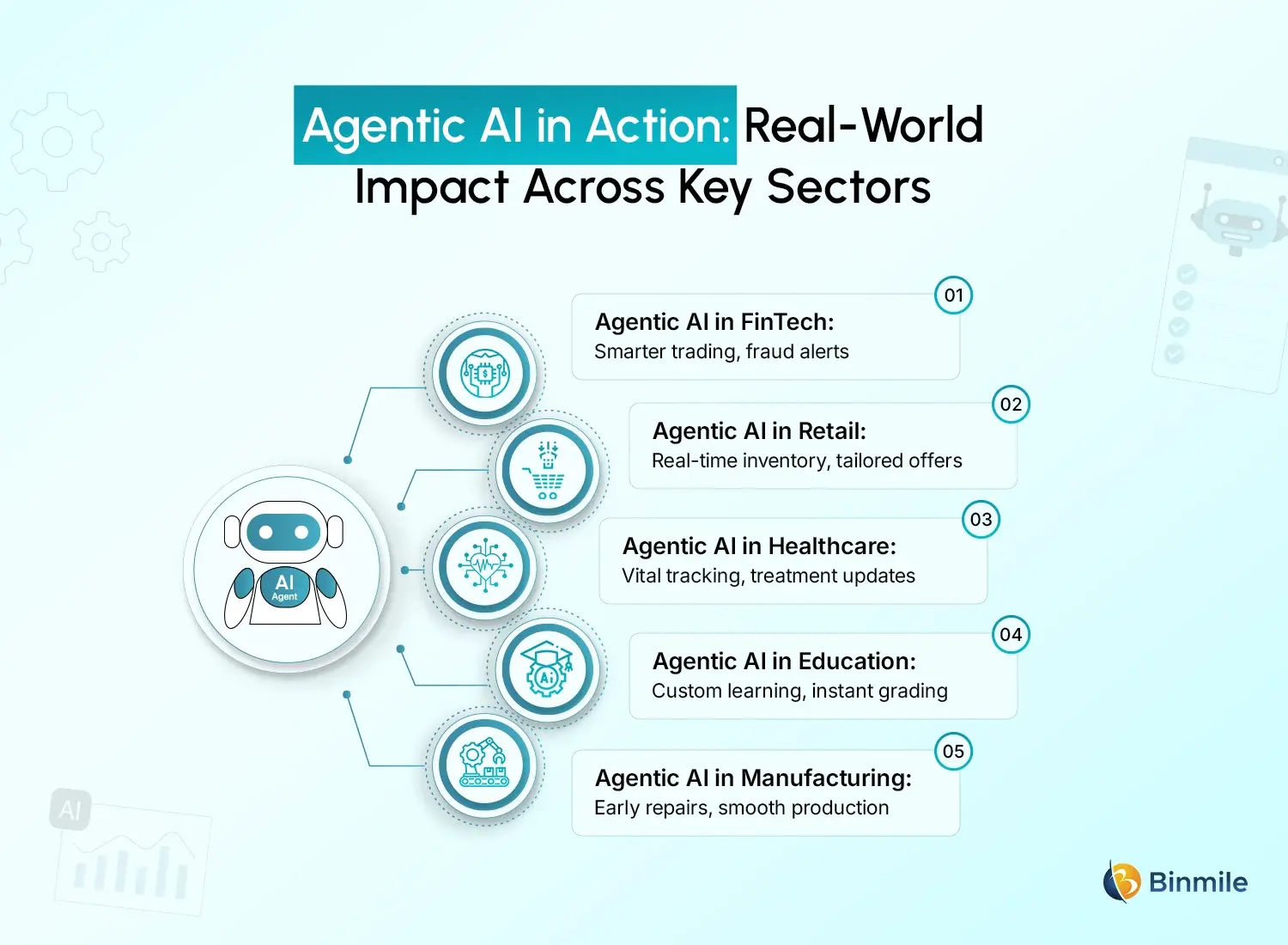
1. FinTech
Agentic AI is transforming FinTech by automating fraud detection and compliance processes. It continuously monitors transactions, adapts to emerging threats without human intervention, and prioritizes suspicious cases, significantly reducing false positives. Additionally, the Agentic AI frameworks can analyze market data in real time to optimize portfolio management, autonomously executing trades aligned with strategic objectives.
This proactive approach allows financial institutions to respond quickly to market fluctuations, strengthen security, and maintain GDPR Fintech compliance while reducing manual oversight and improving operational efficiency.
2. Retail
In retail, Agentic AI optimizes supply chain operations by accurately predicting demand and automatically adjusting inventory levels. It responds to disruptions like supplier delays or seasonal changes without human input, ensuring stock availability and minimizing waste. On the customer front, it powers personalized marketing by analyzing shopper behavior and proactively tailoring offers. Also, agentic AI-powerd bots in customer service are able to handle routine queries independently, freeing staff for complex issues, resulting in smoother operations and better customer experiences.
3. Healthcare
Agentic AI enhances healthcare delivery by autonomously monitoring patient vitals through connected devices, alerting medical staff to critical changes promptly. It manages treatment plans dynamically, adjusting dosages and schedules based on real-time data. Administrative tasks like patient follow-ups and documentation are automated, reducing workload on clinicians. By proactively managing care and resources, Agentic AI helps improve patient outcomes, increase operational efficiency, and enable healthcare providers to focus more on critical patient care rather than routine tasks.
4. Education
Agentic AI has the ability to transform education by delivering personalized learning paths that adapt automatically to each student’s progress. It can identify knowledge gaps, recommends targeted exercises, and adjusts difficulty levels without constant teacher intervention. Beyond teaching, AI in education can also automate grading, attendance tracking, and administrative tasks. This system supports educators by scaling individualized instruction, providing timely feedback to learners, and reducing the administrative burden, resulting in improved learning outcomes and more efficient use of teaching resources.
5. Manufacturing
Agentic AI streamlines manufacturing by autonomously monitoring production lines to predict equipment failures and schedule maintenance before issues arise. It dynamically adjusts workflows to optimize efficiency and flags quality problems in real time, ensuring consistent product standards. By coordinating multiple machines and processes without human supervision, it reduces downtime and operational costs. This adaptive approach enables factories to respond swiftly to changing demands, improve throughput, and maintain competitive advantage in fast-paced markets, making Agentic AI tools, a foundational component of modern supply chain technology.
Agentic AI Trends to Watch Out For
- Robotics: Agentic AI-powered robots to streamline warehouse automation and manufacturing processes. For instance, Amazon warehouses have started to employ robots in fulfillment centers to operate independently and handle complex tasks.
- Self-Healing Data Pipelines: Another trend is that AI agents autonomously monitor, diagnose, and repair data flows. Example: Monte Carlo uses agentic AI for data observability, detecting schema drift and fixing pipeline issues without manual intervention.
- Human Resources: Involving Agentic AI with human resources can empower organizations to automate routine work and provide personalized responses to employees, giving HR professionals time to deal with more strategic priorities.
- Software Development: Agentic AI is already reshaping internal software development through predictive coding, autonomous testing, and intelligent workflow managers. While current implementations are task-specific, the future promises fully autonomous agents. We can expect these agents to be capable of managing entire development lifecycles, enabling leaner delivery models and redefining developer roles.
Closing Statement on Agentic AI
There’s no doubt that the emergence of Agentic AI has become a defining force in reshaping how intelligent systems operate and deliver value. By moving beyond passive, prompt-driven responses to proactive, goal-oriented action, it is enabling industries to achieve greater efficiency, adaptability, and innovation. Hopefully, this blog has provided a clear understanding of how embracing Agentic AI can help you stay ahead of technological shifts while opening new possibilities for operational excellence. In this blog, we also discussed how agentic AI vs generative AI works, to let you fully realize these intelligent systems potential.
However, to automate complex and time-consuming workflows, make intelligent decisions, and drive efficiency at scale without losing visibility, control, or going above budget is easier said than done. To accelerate the adoption of generative AI-powered applications and agentic AI tools, partner with an experienced AI solutions provider. The AI experts can accelerate your ability to design, deploy, and scale autonomous systems that drive measurable business impact.
To explore how Agentic AI can be applied to your business, contact our AI experts today and start building solutions that think, act, and deliver.
